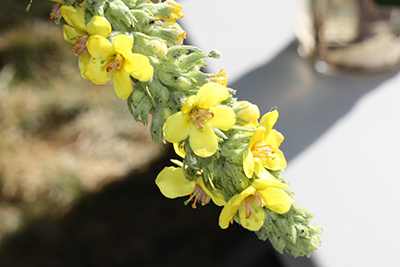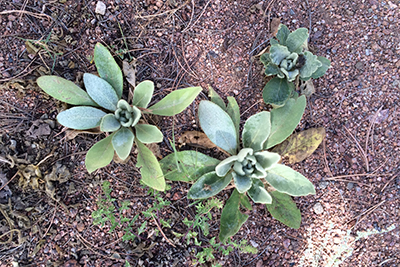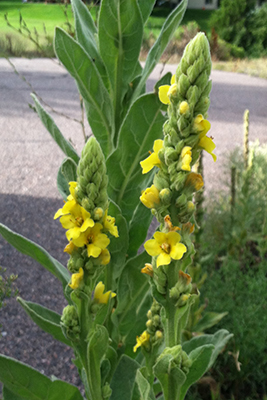Common Mullein
Verbascum thapsus
Keys to Identification
- Flowers are yellow, saucer-shaped, attached to the stem
- Leaves are oblong and woolly with a rounded tip
- Stems are erect, rigid, up to 6 feet tall, covered with woolly hairs
Family
Scrophulariaceae – Figwort Family
Other Names
Flannel plant, velvet dock, woolly mullein, Jupiter’s staff
USDA Code
VETH
Legal Status
Colorado Noxious Weed List C
Identification
Lifecycle
Biennial. First year plants are a basal rosette of oblong leaves covered with woolly hairs. The plant bolts in the second year and then dies after flowering
Growth form
Forb/herb
Flower
Flowers are five-petaled and yellow. Grow in terminal spikes that can be 20+ inches long. Flowering June through August
Seeds/Fruit
The fruit is an ovoid capsule that splits
Leaves
Basal rosette of woolly leaves the first year followed by woolly stem leaves the second year. Stem leaves alternate, somewhat clasping, and decrease in size towards the end of the stem
Stems
Thick, erect, nearly leafless. Two to six feet tall
Roots
Thick taproot
Seedling
Basal rosette of hairy, broad, oblong leaves. Leaves have a long petiole and entire margins
Similar Species
Exotics
Lamb’s ears (Stachys byzantina).
Moth mullein (Verbascum blattaria) Colorado noxious weed, List B
Natives
Miner’s candle (Cryptantha virgata)
Green gentian (Fraser speciosa)
Impacts
Agricultural
Rarely eaten by animals. May form large patches that reduce grazing. Does not survive tilling
Ecological
Once established it grows quickly to form a dense ground cover. It will overtake and displace native species. At high densities, it may prevent establishment of native herbs and grasses following fires or other disturbances.
Found in neglected meadows, forest openings, pastures, fence rows, roadsides, and industrial areas
Human
Leaf hairs may irritate human skin. May affect some recreational activities and impose a negative visual effect on cultural sites
Habitat and Distribution
General requirements
Occurs in areas with an average annual precipitation of 20-60 in. (0.5-1.5 m) and a 140-day growing season. Prefers well-drained soils with pH 6.5 to 7.8. Prefers dry sandy soils but can grow in chalk and limestone. Found in meadows, prairies, desert shrublands, chaparral, deciduous woodlands, and coniferous forests
Distribution
Found in all US states and throughout most of North America. Within the contiguous US, common mullein is often described widespread, conspicuous, or everywhere. In much of the US, common mullein as considered adventive or naturalized
Historical
Native to Europe and Asia. First noted in NA in the mid-1700’s
Biology/Ecology
Life cycle
Biennial. The first year rosette undergoes vernalization in the fall/winter. Vernalization is required to induce flowering the following spring
Mode of reproduction
Seed
Seed production
Mature plants can produce up to 100,000 or more per plant
Seed bank
Seeds may last 100+ years in the soil
Dispersal
Seeds drop to the ground, usually within a few feet of the plant
References
Colorado Department of Agriculture – Common mullein fact sheet – https://www.colorado.gov/pacific/agconservation/common-mullein
BugwoodWiki – https://wiki.bugwood.org/Verbascum_thapsus#Description
Forb Seedling Identification Guide, NRCS, Pullman Plant Materials Center. P.138. Authors: Pamela Pavek, USDA NRCS; Brenda Erhardt, Latah Soil and Water Conservation District; Trish Heekin, Latah Soil and Water Conservation District; Richard Old, XIS Services, Inc.
Invasive Plant Atlas of the United States – https://www.invasiveplantatlas.org/subject.html?sub=3080
USDA-USFS Fire Effects Information System (FEIS). “Verbascum Thapsus” – https://www.feis-crs.org/feis/
Invasive.org – https://www.invasive.org/weedcd/pdfs/wgw/commonmullein.pdf





